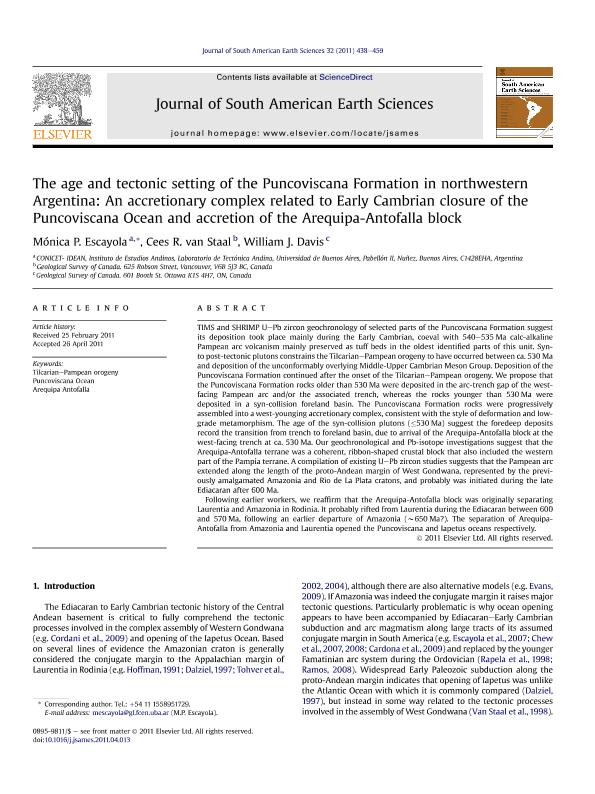Artículo
The age and tectonic setting of the Puncoviscana Formation in northwestern Argentina: An accretionary complex related to Early Cambrian closure of the Puncoviscana Ocean and accretion of the Arequipa-Antofalla block
Fecha de publicación:
12/2011
Editorial:
Pergamon-Elsevier Science Ltd
Revista:
Journal of South American Earth Sciences
ISSN:
0895-9811
Idioma:
Inglés
Tipo de recurso:
Artículo publicado
Clasificación temática:
Resumen
TIMS and SHRIMP U-Pb zircon geochronology of selected parts of the Puncoviscana Formation suggest its deposition took place mainly during the Early Cambrian, coeval with 540-535. Ma calc-alkaline Pampean arc volcanism mainly preserved as tuff beds in the oldest identified parts of this unit. Syn- to post-tectonic plutons constrains the Tilcarian-Pampean orogeny to have occurred between ca. 530. Ma and deposition of the unconformably overlying Middle-Upper Cambrian Meson Group. Deposition of the Puncoviscana Formation continued after the onset of the Tilcarian-Pampean orogeny. We propose that the Puncoviscana Formation rocks older than 530. Ma were deposited in the arc-trench gap of the west-facing Pampean arc and/or the associated trench, whereas the rocks younger than 530. Ma were deposited in a syn-collision foreland basin. The Puncoviscana Formation rocks were progressively assembled into a west-younging accretionary complex, consistent with the style of deformation and low-grade metamorphism. The age of the syn-collision plutons (≤530. Ma) suggest the foredeep deposits record the transition from trench to foreland basin, due to arrival of the Arequipa-Antofalla block at the west-facing trench at ca. 530. Ma. Our geochronological and Pb-isotope investigations suggest that the Arequipa-Antofalla terrane was a coherent, ribbon-shaped crustal block that also included the western part of the Pampia terrane. A compilation of existing U-Pb zircon studies suggests that the Pampean arc extended along the length of the proto-Andean margin of West Gondwana, represented by the previously amalgamated Amazonia and Rio de La Plata cratons, and probably was initiated during the late Ediacaran after 600. Ma.Following earlier workers, we reaffirm that the Arequipa-Antofalla block was originally separating Laurentia and Amazonia in Rodinia. It probably rifted from Laurentia during the Ediacaran between 600 and 570. Ma, following an earlier departure of Amazonia (∼650. Ma?). The separation of Arequipa-Antofalla from Amazonia and Laurentia opened the Puncoviscana and Iapetus oceans respectively.
Palabras clave:
AREQUIPA ANTOFALLA
,
PUNCOVISCANA OCEAN
,
TILCARIAN-PAMPEAN OROGENY
Archivos asociados
Licencia
Identificadores
Colecciones
Articulos(IDEAN)
Articulos de INSTITUTO DE ESTUDIOS ANDINOS "DON PABLO GROEBER"
Articulos de INSTITUTO DE ESTUDIOS ANDINOS "DON PABLO GROEBER"
Citación
Escayola, Monica Patricia; van Staal, Cees R.; Davis, William J.; The age and tectonic setting of the Puncoviscana Formation in northwestern Argentina: An accretionary complex related to Early Cambrian closure of the Puncoviscana Ocean and accretion of the Arequipa-Antofalla block; Pergamon-Elsevier Science Ltd; Journal of South American Earth Sciences; 32; 4; 12-2011; 438-459
Compartir
Altmétricas




